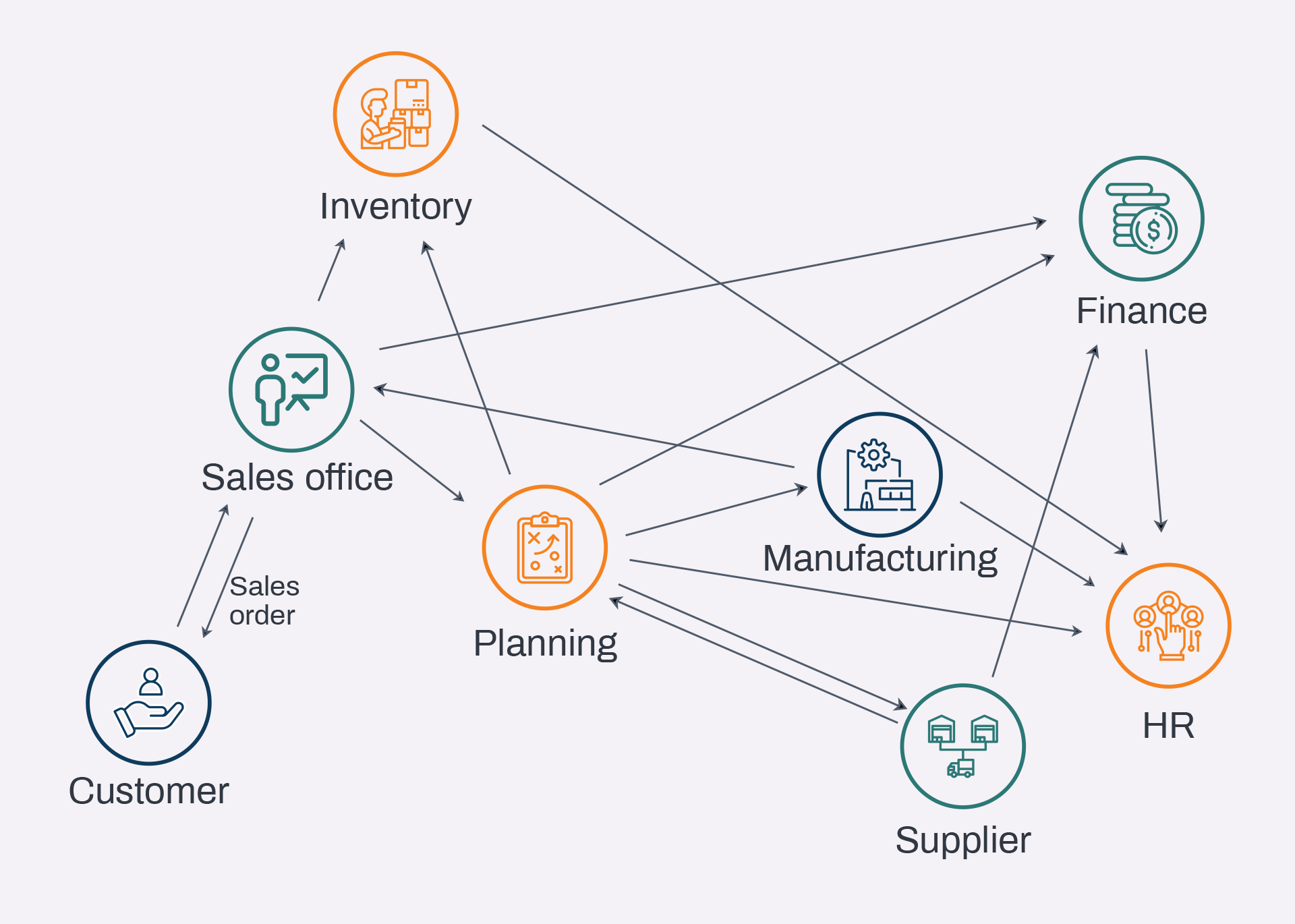ERP implementations can be a real challenge, particularly for the Finance Director, who needs a better view on ROI figures for the investment to justify the reasons for the project going ahead. Often, the prime driver for ERP solutions is to standardise and streamline processes to make them more efficient, and automate where possible to reduce manual intervention.
One sometimes overlooked area is how ERP solutions can drive improved visibility and by having ‘one version of the truth’, this can drive profitability in itself.
I’ll explain how the right ERP solution can improve the ability to see relevant company data and information clearly, quickly and accurately to drive decision making and other actions that can lead to business benefits such as increased profit.
Centralised vs decentralised

Let's start by quickly covering the differences between centralised and decentralised businesses.
In a decentralised business, each function tends to operate separately in silos and have their own data. Perhaps even systems.
When information is needed by one department outside of its boundaries, it has to be ‘fetched’ from the relevant department using a variety of approaches. This can be illustrated by the information request flows created upon receiving an order enquiry within sales which needs confirmation back to the customer on delivery and price.
 An example to show the information flow complexities to be addressed
An example to show the information flow complexities to be addressed
This results in a very inefficient process, often leading to data being duplicated to try and speed up the response, and by the time all the relevant details have been gathered, the information may be out of date and the customer may have gone elsewhere.
Introducing the ERP system...
This may seem simplistic, but what managers and key users actually need is to see the right information for themselves immediately, in a format they can understand. This enables them to make fast, effective and correct decisions that drive the right business outcomes and maintain the right level of managerial control.
ERP drives a centralised approach which means:
- Data is held on a shared database, rather than in silos, and retrieved from the database when needed rather than from a department
- Duplication of data is avoided since it is only held or mastered in one place
- Subsequently, effort is reduced and key information can be accessed ‘there and then’
- Timely actions are taken which can, as shown in the example above, potentially avoid a lost sale.

Revenue is impacted by customer experience, accuracy and reliability, as well as price. Rapid access of the right information through full visibility enables customers to get what they need faster since information is up-to-date and accurate. This results in improved customer satisfaction and a higher reliability perception of the supplier which can only help drive increased revenue and avoid the customer going elsewhere.
Benefits of ERP systems
Right information, right time, right person
A key insight for Senior Managers is to make money, you have to know how much you’re spending and where. ERP can help support this by:
- Enabling relevant data linked to various activities from a cost and accounting perspective to be visible which means...
- ...businesses can assess how particular activities or projects are progressing together and review underlying financial performance which means...
- ...profitability projections can be revised continually and steps taken to address proactively rather than managing shortfalls after the event.
Similarly, if data and information can be made readily available to key decision makers in the right format using tools like Business Intelligence and Analytics alongside ERP, they can then:
- Get a true picture of business operations on a continuous basis in real-time ‘warts and all’ which means….
- ...decisions can be made in real-time which can affect overall performance and…
- ...improvement activities can be targeted at those areas with the maximum benefit to improve performance and drive down costs, rather than ‘scatter gun’ and…
- ...the same data sources can validate the impact of any changes made and measure the benefits.
Mobility and cloud

Having access to data and information whether you are in the office or not is key to an ‘always on’ approach. Modern ERP systems run comfortably on both handheld devices and laptops. Plus, they use the same data models which ensures that key players in the business can keep track of business performance metrics and KPIs whenever they need to.
What this means is that:
- Prompt decisions required to address a potential issue or exploit a particular opportunity are not subject to delay, and the benefits realised quicker
- Cloud hosting can provide further improvements for both the access to information from anywhere, and with the relevant security in place to ensure data integrity and protection
- If a customer wants to share critical data on their requirements in real time so that you can make exactly what is needed when they need it, you can get real-time access to that data from anywhere at any time and can act accordingly
Better management of rebates and discounts
Businesses often run on very tight margins so it’s essential you can track rebates and discounts and ensure they are being applied correctly and that you’re collecting them. Without an easy-to-use solution to track them, there’s a real risk that you may be giving customers larger discounts than intended (impacting revenue), or lower discounts (resulting in a time-consuming crediting process after the event).
The rationale behind rebates and discounts is to ensure the right price, volume and mix to drive customer satisfaction and ultimately increase revenue by remaining competitive. Not managing these correctly can lead to costly errors and poor customer service so having the process in place is a win for both customers and your company.
ERP can help support this process by:
- Enabling tracking of both discounts and rebates by extracting the relevant information from the shared database to ensure that they’re correct
- Setting up the discount and rebate parameters correctly so that the system will always apply the right rebates or discounts systematically
- Validating when rebates should be applied over extended trading periods and used as a lever to drive more business when thresholds may not be reached
Faster products to market

Getting products to market quickly is key to be able to exploit opportunities and drive additional revenue. To do this effectively requires effective collaboration and information sharing during new product development, which is where ERP can help through:
- Improved information availability and collaboration tools
- Improved coordination of resources and data across functions
- The use of project planning tools and holding data digitally in one place such as trial BOMs or trial costs
This means the whole process is more controlled with less wasted effort and businesses can take advantage of potential gaps in the market much quicker. This can drive increased revenue whilst being able to continually assess costs to determine the ongoing profitability of a proposed new product.
Increased collaboration and customer satisfaction
In most businesses, having supply chain transparency is essential to success. Producers need to be tightly integrated with their vendors to manage inbound supplies and to readily provide product, price, availability, and shipment information to their customers. This is becoming more relevant with the increase in global supply networks.
For businesses to react effectively to changing demands, they need:
- Visibility of Customer Stocks and EPOS data to assess likely demand and replenishment
- Accurate information about the supplier's availability and capacity to ensure lead times to supply are significantly reduced and availability improved
Those businesses who have this visibility can capitalise better on changes in demand which, in turn, drives increased revenue by having product available when the customer needs it.
ERP can again help support this approach by providing:
- Visibility of internal stock levels
- Visibility of any vendor-managed inventories
- Electronic Kanbans to trigger replenishment
Integrating external data from both customers and suppliers to an ERP system provides all the relevant information in one place and improves costs through greater efficiency. Further developments to add e-commerce offerings linked to a core ERP solution can also reduce order-taking costs, improve order fulfilment, and increase customer satisfaction, all of which can lead to increased revenue.
ERP implementation: A big decision that leads to big benefits

Focussing on driving improvements and standardisation in key processes should be a key factor in choosing the right solution. However, improved data and information availability and visibility shouldn’t be overlooked as a key benefit when clearly, it can impact your bottom-line.
To succeed in today’s fast changing business environment, access to information is key to make the right decisions quickly. Without solutions like ERP, this can be a lengthy process and lead to slow decision making which can be costly if it relates to new product introduction or satisfying customers.
Having a system which can quickly provide real-time accurate information to key stakeholders to make the right cost and investment decisions can have a significant impact on customer satisfaction and product performance and hence revenue and profit. Many ERP solutions have embedded features which enable access to company data in a readable and understandable format.
Combine this with time to access and accuracy of the specific information needed, and you have the platform to make the right decisions and drive your business forward.
But, when it comes to ERPs for the food industry, a generic one won't cut it. You'll need a specialist one. Discover what features you should look for in a food ERP software in our guide below.

